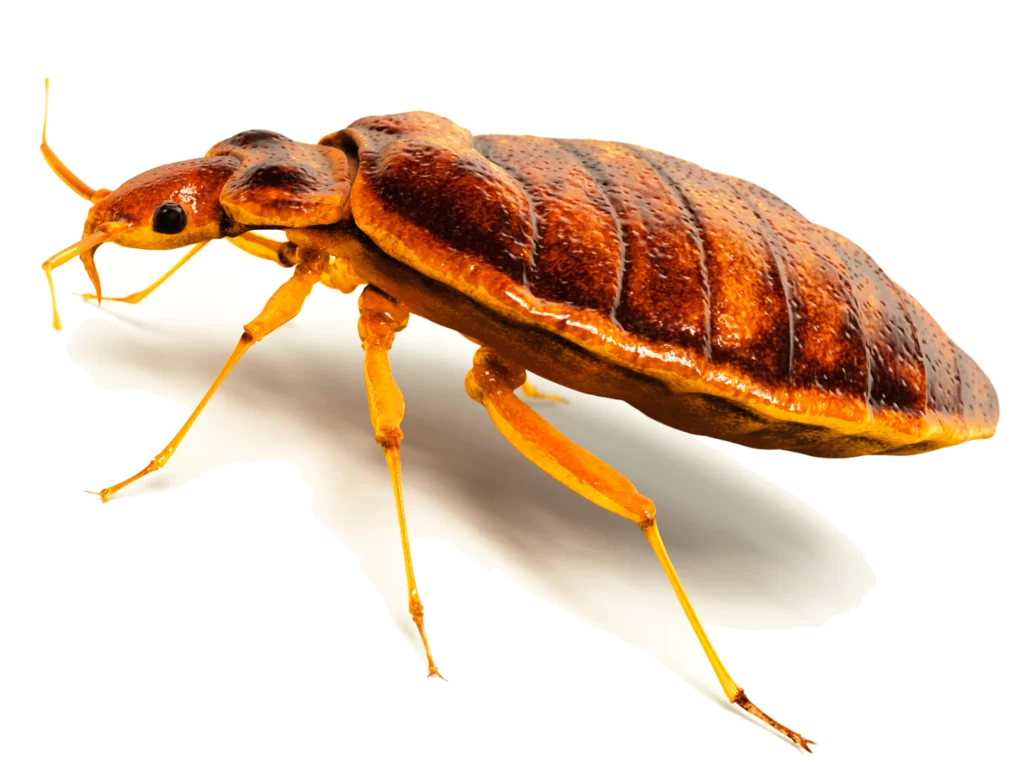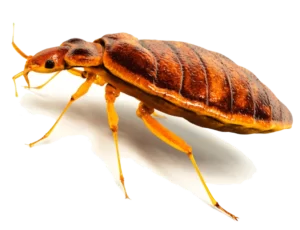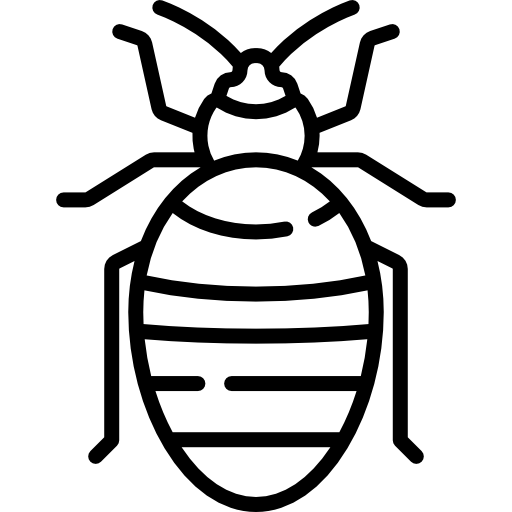
If you live in Montreal and have experienced a bedbug infestation, you know how stressful and disruptive it can be. Bed bugs are difficult to eradicate and can quickly spread throughout your home if not dealt with quickly. Fortunately, SOS-Extermination is there to help you. As an experienced extermination company specializing in bed bug elimination, SOS-Extermination has the skills and expertise to rid your home of pests once again.
Bedbugs are small, reddish insects that feed on the blood of humans and animals. They are known to be particularly difficult to kill, and a single female can lay hundreds of eggs in her lifetime. Bedbugs can also survive for months without feeding, which means they can lie dormant for a long time before showing up.
Bed bugs are tiny insects that usually measure around 5mm in length. They have flat, oval-shaped bodies, and are reddish-brown in color. Bedbugs feed exclusively on blood and are most active at night, when their hosts are asleep. They can be found in a variety of environments, including homes, hotels, and public transport.
| French name: | Bed bug |
| English name: | Bedbug, Common Bedbug |
| Latin name: | Cimex lectularius |
| Class: | Insects |
| Order: | Hemiptera |
| Family: | cimicidae |

Bed bugs are not always easy to spot, as they are small and tend to hide in cracks and crevices during the day. However, there are signs that indicate you may have a bed bug infestation in your home. These signs include:
Getting rid of bedbugs is a complex and time-consuming process that requires the expertise of a professional extermination company. SOS-Extermination uses a multi-step approach to bed bug elimination that includes:
Inspection: A thorough inspection of your home to identify the extent of the infestation and areas where bed bugs are hiding. Treatment: The use of specialized insecticides to kill bed bugs and their eggs.
Follow-up: A follow-up visit to ensure that all bed bugs have been eliminated and to resolve any remaining issues.

SOS-Extermination is an experienced extermination company specializing in the elimination of bed bugs. She uses state-of-the-art equipment and techniques to ensure that your home is pest-free. In addition, SOS-Extermination offers a 100% satisfaction guarantee, which means that it will do everything possible to ensure that you are completely satisfied with its services.
Cockroaches are attracted to your home for a variety of reasons. This is how cockroaches get into your home:
Cockroaches enter your home for 4 main reasons: food, water, warmth and shelter. They are most often attracted by: dirty dishes, garbage, excess humidity, crumbs, animal food or cardboard.
Cockroaches are much more fond of dark, warm and humid places. For example the bathroom, the kitchen, the cabinets, the back of the appliances.
It has to do with the reproductive cycle. They keep coming back as they leave a sac of eggs before dying to reproduce. Cockroaches can also come back if you have too much food.
If you kill them, the risk is to spread the eggs everywhere. In fact, the female releases her egg sac before she dies. The secretion of aggregation of pheromones could also attract other cockroaches.
The common bed bug, also known by the scientific name Cimex lectularius, is a small insect that measures around 5-7mm in length. It has an oval, flat shape, which makes it easy to hide in cracks and crevices. The color of the common bed bug varies from light brown to reddish brown.
Common bed bugs are nocturnal parasites that feed on the blood of humans and animals. They prefer to feed at night, but may also feed during the day if hungry. The common bed bug bite is painless, but can cause itching, redness and inflammation.
Common bedbugs can be found anywhere people sleep or rest, including homes, hotels, motels, and dormitories. They hide in mattresses, box springs, bed frames, upholstered furniture, curtains and carpets.
To identify a common bed bug, look for physical signs such as blood stains on sheets, mattresses, and pillows, bed bug egg shells, bed bug droppings (small black spots), and dead or alive bed bugs. Common bedbugs also emit a sweet, musky smell, although this smell is not always present.


The tropical bed bug, or Cimex hemipterus in Latin, is an insect that looks a lot like the common bed bug. It measures about 4 to 5 mm in length and has an oval and flat shape. Its color varies from light brown to dark brown.
Like the common bed bug, the tropical bed bug feeds on the blood of humans and animals. She also prefers to feed at night, but may feed during the day if hungry. Bites from tropical bedbugs can cause itching, redness and inflammation.
Tropical bed bugs are primarily found in tropical and subtropical regions, but have been reported worldwide. They hide in the same places as the common bed bug, such as mattresses, box springs, bed frames, upholstered furniture, curtains and carpets.
To identify a tropical bed bug, look for the same physical signs as for the common bed bug, such as blood stains on sheets, mattresses, and pillows, bed bug egg shells, feces from bed bugs (small black spots) and dead or alive bed bugs. The main difference between the two species is that the tropical bed bug has longer hairs on its head, which is visible under a microscope.
The bird’s bed bug, also known as Cimex adjunctus in Latin, is a species of bed bug that is often found in bird nests. It measures approximately 4 mm in length and has an oval and flat shape. Its color varies from light brown to dark brown.
Unlike the other two species of bed bugs, the bird bed bug feeds exclusively on the blood of birds. It therefore does not bite humans and pets. Bird bed bugs prefer bird nests and other places where birds nest.
Bird bed bugs are usually found in bird nests, trees, buildings or abandoned buildings where birds have built their nests. They are also often found in birdhouses or bird feeders.
To identify a bird’s bedbug, look for typical signs of bedbug presence, such as bloodstains on sheets, mattresses, and pillows, bedbug eggshells, droppings bed bugs (small black spots) and dead or alive bed bugs. Bird bed bugs also have longer hairs on their heads, which distinguishes them from the other two species of bed bugs.


The bat bed bug, also known as Cimex pilosellus in Latin, is a species of bed bug that feeds exclusively on the blood of bats. It measures about 3 mm in length and has an oval and flat shape. Its color varies from light brown to dark brown.
Bat bed bugs feed exclusively on the blood of bats. They can move easily between bats, but they do not bite humans or pets. They are often found in caves, attics and other places where bats nest.
Bat bed bugs are commonly found in caves and attics where bats have built their nests. They are also often found in abandoned buildings where bats have taken up residence.
To identify a bed bug from the bat, look for typical signs that bed bugs are present, such as blood stains on sheets, mattresses, and pillows, bed bug egg shells, bed bug droppings (small black specks) and dead or alive bed bugs. Bat bed bugs also have longer hairs on their heads, which distinguishes them from the other two species of bed bugs.
Anwser:: It clings to our clothes, and travels easily from one destination to another. Rarely our fault, often 5 minutes in an infested place is enough to bring it back to our home.
Anwser:: This is not a problem to be taken lightly. Many are those who develop anxiety and depression because very difficult to exterminate but not impossible.
Anwser:: Because we are leaders in our field. Our technique was developed in the worst neighborhoods of Montreal. SOS-Extermination offers you a solid and extended guarantee depending on the insect to be eliminated. Our success rate exceeds 95% for infestations of categories 8 to 10.
Anwser:: After the first treatment, in 95% of cases you will no longer be a victim of their bed bug bite. After the second treatment, the place is sterilized (21 days for complete sterilization)

SOS-Extermination offre des services de lutte et de prévention parasitaire partout à Montréal et Ottawa. Les parasites domestiques peuvent être difficiles à éradiquer.
Les insectes ont décidé d’emménager chez vous ? Dites leur Non, vous n’avez plus besoin de les héberger. Reprenez le contrôle de votre maison!